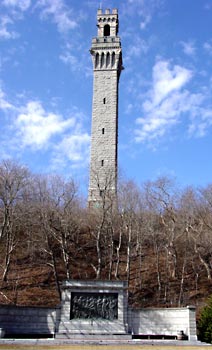Honoring the Bronze Bas Relief at the Base of Provincetown's Pilgrim Monument
 Provincetown's Pilgrim Monument
Provincetown's Pilgrim MonumentPhotograph by Peter Whitlock
When you sit down at your beautifully appointed Thanksgiving table this year, and gaze at your guests as they dive into the turkey, stuffing, sweet potatoes, pumpkin or pecan pie, remember that this beloved family-oriented holiday began as a tribute to the pilgrims who landed on our shores—minus the turkey!
Although many people associate the pilgrims with Plymouth Rock, they actually landed first at Provincetown, Massachusetts, where they spent five weeks exploring the tip of Cape Cod before sailing onto Plymouth Rock. Located at the base of Provincetown’s commemorative 252- foot granite Pilgrim Monument is a stunning bronze bas relief created by the renown sculptor Cyrus E. Dallin, (1861 – 1944), signifying the signing of the important Mayflower Compact by the Pilgrims, in 1620. In fact, millions of visitors and generations of residents have climbed the monument, and it is one of the most popular visitor attractions in Provincetown.
“The memorial bas relief is framed by a granite structure seventy feet long and twenty feet high,” says Laurel Guadazno, Education/Program Manager at the Pilgrim Monument and Provincetown Museum. “The bronze bas relief, cast by the Gorham Corporation of Providence, Rhode Island, is nine by sixteen feet and the entire structure cost $40,000. The bas relief was designed by the well known artist, Cyrus Dallin, who gained notice when he won the contract to execute the statue of Paul Revere to be placed in downtown Boston, near Old North Church.”
Another well-known and typical Dallin work, according to Guadazno, is the Appeal to the Great Spirit located in front of the Boston Museum of Fine Arts.
“Many local guides indicate that the bas relief was put in place in 1920,” she adds. “For instance, M.C. Hatch, in The Log of Provincetown and Truro on Cape Cod, writes, ‘In 1920, Provincetown held her Tercentenary Celebration, a fine affair, with parades, speeches, floats and distinguished visitors. It was at this time that the beautiful bas relief, The Signing of the Compact, was unveiled.’ There is no record, however, of its unveiling in the program of events that took place that year, and the bas relief itself is dated 1921. Some evidence indicates that the park, where the bas relief is located, was created in 1921 and it is likely that the bas relief was installed sometime after that to commemorate the incorporation of the town. Whenever it was installed, it is now a well-known landmark and a fitting tribute to an important historical event, the signing of the Mayflower Compact in Provincetown Harbor.”
 Closeup of Pilgrim Monument Bronze Bas Relief
Closeup of Pilgrim Monument Bronze Bas Relief Photograph by Peter Whitlock
Later, to commemorate this landing, $92,000 was raised for construction of the tower as well as the site. But, they required a design that would honor the Pilgrims and the signing of the Mayflower Compact in the harbor. The group thought about it and chose a design of a bell tower, or campanile, patterned after the Torre del Mangia in Siena, Italy, another example of this type of tower. Dallin, well known in the world for his American Indian sculptures, beginning with the Ute Indians in Utah, as well as the famous Medicine Man in Fairmount Park (Philadelphia), was called in, to start a major sculpture that was erected overlooking Plymouth Bay, of Massasoit, the friendly chief of the Wampagnogas Tribe. It was completed in 1920 and stands proudly greeting visitors on Cole’s Hill, in Plymouth. Another casting of this famous figure, funded by the Nicholas Morgan Sr. Foundation, stands proudly in front of the Utah State Capitol Building.
Also in this Issue:
- Artists and Alchemists: The Art of Copper Electroforming
- Copper Artist Burt Squires Revives the Historic Barn Star
- Martino Hoss and Pastel on Copper: Vignettes of a Memory
- Honoring the Bronze Bas Relief at the Base of Provincetown's Pilgrim Monument
- New Gallery for Native North American Art Opens at Metropolitan Museum, Rare Copper Mask on Display
